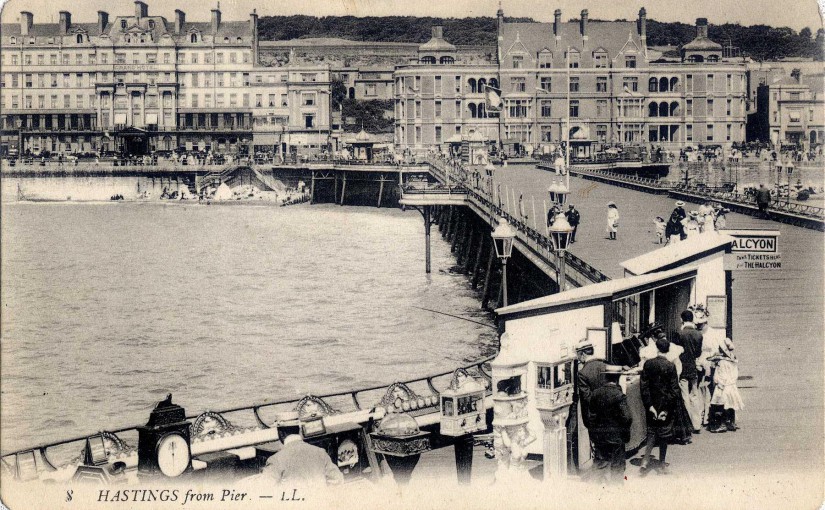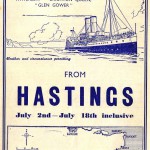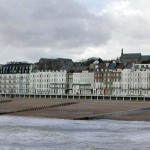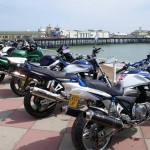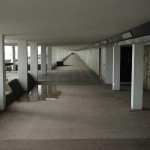The area around the pier has changed dramatically over the last hundred years, as has the pier itself. We can see from this contemporary postcard by the famous postcard photographer Louis Levy that the Grand Hotel on the left, the municipal Hospital on the right, and behind it. Lady Jocelyn’s house, have all gone.
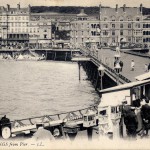
The road between the hospital and the Grand Hotel has been considerably widened as has the pier, but notice the little balconies, marking the low water mark are quite visible. Notice too the amusement machines that would have had to be taken in every night and the kiosk selling tickets for trips on the “Halcyon” later on you could use the landing stage at the end of the pier to travel by Campbell’s ‘saloon steamer’ to Boulogne or up and down the coast from Dover to the Isle of Wight. Just before the war, in 1938 a day return to the Isle of Wight would cost you 8/6 — that is 43p in today’s money. Boulogne was 11/6 return – 58p. During the war, the pier was cut in half, so that it couldn’t be used by an invading enemy as a bridgehead. Repairs were underway by 1946 and you can see a temporary bridge joining the two halves of the pier together the centre of this picture, and at the end of the pier cranes appear to be repairing the landing stages.
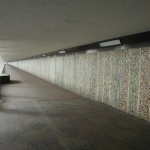
Back in 2002 when you could still go to the end of the pier and on a slightly overcast day in February I photographed the double deck promenade known locally as Bottle Alley. This revolutionary promenade was built in the early ’30’s by Sidney Little, Hastings’ “Concrete King” it’s half a mile long, stretching from the Pier to Warrior Square. The rear walls of the lower deck are faced with glass from broken bottles and it wasn’t long before some wag christened the covered lower promenade “Bottle Alley” but the broken glass wasn’t merely decorative, it protected the concrete from the corrosive effect of the sea air at close quarters so it must be recognised that Sidney Little was a pioneering recycler even if they didn’t have a name for it in those days .
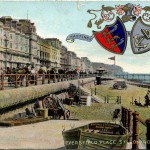
you what was there before Bottle Alley. Notice the bathing machines,
and the spare wheel is propped up against the wall. This was one
of the few places that bathing machines, could be drawn up from the
beach, because elsewhere, the sea wall got in the
His promenade extension utilised old tramway granite setts to face the walls that take the full force of the sea and the underground car parks were reinforced with old tram rails. Many of the groynes that stabilise the beach were also faced with granite setts and lasted over 70 years. Sadly this unique structure has been under threat for some years by an uncaring council who can’t make up their minds what to do with it and are waiting for the concrete cancer to spread so that it will fall down or they can pay a consultant to tell them that it is beyond repair and will have to be demolished instead of recognizing the potential of this iconic structure.
When bottle alley was new it was lit from end to end, and there were cafes serving the balcony areas which once had glass and mahogany shutters to reduce the effect of bad weather and the whole area became a popular rendezvous even at night. After the war, successive pennypinching councils reduced the lighting, failed to invest in cleaning and maintenance and apparently just wished the whole thing would go away.
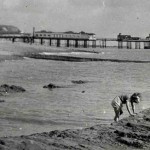
you what was there before Bottle Alley. Notice the bathing machines,
and the spare wheel is propped up against the wall. This was one
of the few places that bathing machines, could be drawn up from the
beach, because elsewhere, the sea wall got in the
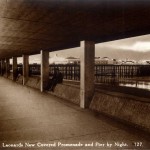
make!
So what’s the way forward with Bottle Alley? Those in favour of its demolition appear to have no idea of the noise, dust and monumental disruption that this would cause, not just to the town but to the main A259 road that it backs on to, not to mention the unacceptably high amount of carbon emissions produced by the equipment breaking up the concrete, and the trucks taking it away.Repairs to the concrete need to be started right away to prevent the structure going past the point of no return and then the whole area given a thorough clean. It should then be properly lit with modern low energy high-intensity lighting and the cafes reinstated. Strategically placed interpretive panels telling the story of Bottle Alley and proving that Hastings was a pioneer in recycling should also be provided. That’s all very well, I hear you say, but what can we do with it once we’ve spent all this money on it? The payback is that Hastings could have the country’s first half mile under cover seaside Art Gallery, where local artists could display their art for most of the year it could be a half mile farmer’s market, a half mile continental market, a half mile fleamarket or all of these things, on subsequent days.
It would draw people to the St Leonards end of town, and to the pier. Joined up thinking suggests that, as I have said before, the White Rock Baths should be converted to underground multi-storey car parking, Jerwood should put their art Gallery on the top and the whole, taken together, would provide a unique seaside experience unavailable elsewhere. It might be called regeneration! P.S. I’ve no idea who Lady Jocelyn was either, but we do know where she lived. There are more pictures of the pier on www.1066.
net/hastings-pier and Bottle Alley on www.1066.net/bottlealley
“Hastings Town” June2008
All articles, photographs and drawings on this web site are World Copyright Protected. No reproduction for publication without prior arrangement.
